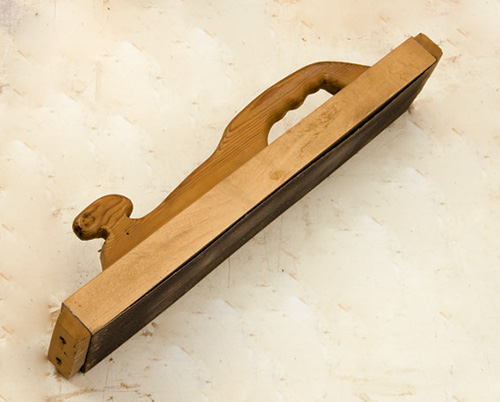
Why is the wood grain in hand plane totes oriented across the length, parallel to the plane base? This design is inarguably structurally flawed, as demonstrated by the frequency of totes breakage. I assume grain direction is traditional for appearance or because it is a more efficient use of wood stock to cut the handles across the grain. Three of the replacement totes I have made (carob, black walnut, padauk) are cut with the handle length parallel to the grain. These handles will never break. The top “tail” and bottom toe are reinforced with splines. My custom scrub plane has a three-ply purpleheart tote. Is there any reason other than tradition for the cross-grain style of plane handles? – Bruce Sibbett
Tim Inman: You’ve got me on this one. I know of no reason for or against in the manufacturing of these handles. Actually, the ones I’ve broken have been on the impact-receiving end of a dropped tool or a dropped board. If I had to bet, I’d say cost of material and ease of manufacturing play big in the grain direction decisions.
Ian Kirby: I assume you are talking about the handles on a metal body plane. The front handle, which to all intents is a knob, is called “the tote.” The handle, the one you push on, is called “the handle.” For what it’s worth, in my sixty years of “constant” plane use, I’ve never broken a handle nor been present when one was broken by a student or fellow worker. My observation is that breakage occurs as a result of misuse. Common mishaps are a blow to the handle by something like a chunk of wood falling on it or the plane being dropped or swept off the bench. In most cases of broken handles on planes it’s evident that the tool has suffered at the hands of its owner in other ways also.
Since the handle is made with the grain going horizontal, this leaves only the middle area of the handle as short grain. That’s the area, however, where the handle is the thickest and it is supported by the metal post which goes through the center. The post has a nut at the end, which, if it’s kept tight, puts the body of the handle into compression, providing considerable support and resistance to breakage.
The laminated handles you made will hold up– they are hardly what could be done in a competitive production setting of the time. Indeed, they are a perfect example of the often recited saying, “form follows function,” although it’s more true to say that “form follows economy.”
You are correct in noting that the grain in the handle goes horizontal. It’s not tradition, it’s simply the best of the alternatives.





